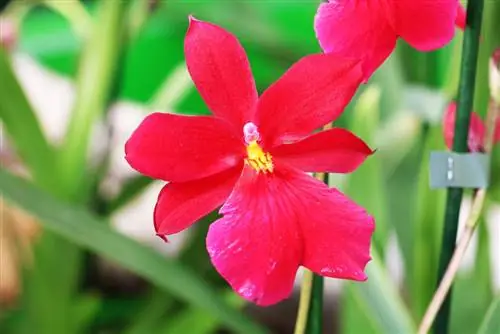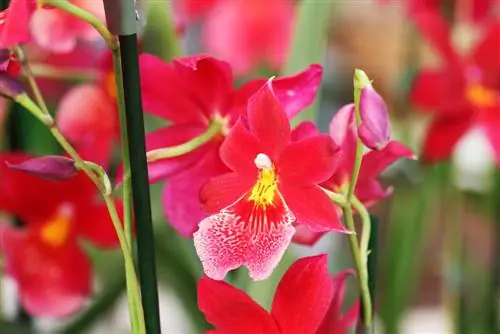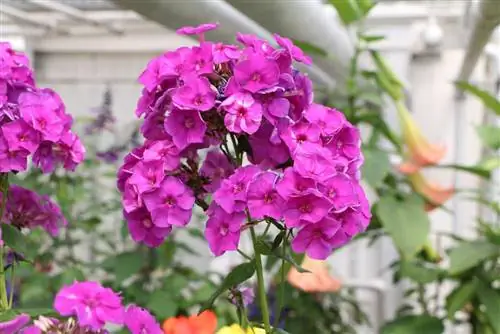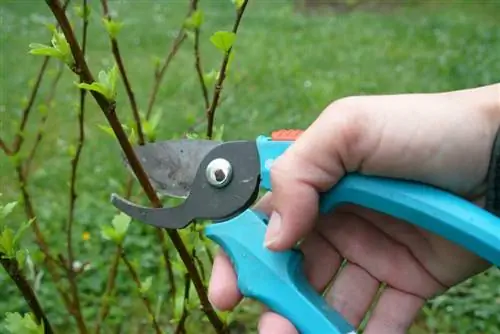- Author admin [email protected].
- Public 2023-12-17 03:39.
- Last modified 2025-01-24 12:45.
The Cambria orchid requires uncomplicated care and is therefore very suitable for orchid beginners. Furthermore, it is a very robust and vigorous plant. It can grow up to 60 cm high.
Care and watering
As a guideline, the substrate must not dry out all year round. This is especially true for spring and summer. But too much moisture is not good for the Cambria orchid either. The irrigation water should be able to drain out of the pot. The plant needs to be watered on average once a week, and at temperatures higher than 20 °C about twice. As an alternative to watering, the pot can be dipped. This means keeping it in a container filled with water until the substrate is saturated.
The excess water must then drain off. You can tell that the plant needs new water when the substrate begins to dry out. In addition to the moisture in the substrate, the moisture in the air is an important factor in care. Regular misting is an option, although the flowers should remain dry. However, misting is not essential for the care of Cambria orchids.
Cambria Orchid Location
- Temperatures between 15 and 25 ° C and a bright location are best for the Cambria orchid.
- Heat above 25 °C can cause burns after just a few hours. Therefore, the plant should be protected from direct sunlight.
- If it is in the house, windows in the immediate vicinity should have a curtain.
- Nevertheless, it makes sense to choose an outdoor location in summer, of course one that is protected from the rain and in the shade.
- In winter, however, the Cambria orchid should get a little sun, but under no circumstances dry heating air.
- Even if the temperatures drop a little, it's not bad. On the contrary: lower temperatures promote flower formation.
Care
If you follow our advice, your Cambria orchid will have a good and long life ahead of it:
Cutting
There are Cambria orchids that bloom all year round. However, the main flowering time is autumn and winter. In order to get a faded plant to bloom again, the dried stems must be removed. The branches can be cut down to the parts that are still alive. Scissors are completely unsuitable for this because they can cause bruising to the plant. That's why it makes sense to use a knife.
Fertilize
The Cambria orchid should not be fertilized more than twice a month. It should receive plenty of special orchid fertilizer from April to September. In winter, fertilization can be reduced, approximately every eight weeks. If you want to skip fertilizing in winter, you can do so without hesitation.
Wintering
The Cambria orchid should be brought into the apartment in winter. A sunny location and slightly cooler temperatures than in summer are ideal. Watering and fertilizing can also be reduced in winter. Otherwise, make sure that the plant does not get any dry heating air and that the humidity is always between 60 and 80 percent.
Repotting
As soon as the substrate shows the first signs of deterioration, i.e. begins to decompose, the plant should be moved to a new pot. This happens approximately every two to three years. The ideal time for repotting is after flowering. Different Cambria species require special orchid substrate. Otherwise, a mixture of bark and peat is sufficient. Ordinary potting soil should not be used.
Propagation
The Cambria orchid is a sympodial plant. This means that it does not have a single style or axis, but grows from several branches. The easiest way to do this orchid is to divide the plant. However, this can be very tricky as it weakens the plant. In any case, you should wait for the flowers to bloom. It should also have six to eight bulbs. Bulbs are the bulb-like parts of the orchid that protrude directly from the soil. They store moisture and nutrients. You also develop flower shoots. If the plant has fewer than five bulbs, it may not bloom after division.
Pests
Cambria orchids are very often affected by mealybugs and mealybugs. Unfortunately, it is difficult to treat a plant against them. As a preventive measure, they should be checked regularly for the small animals, especially under the leaves. If the plant is infested with lice, it is recommended to remove the visible lice by hand and, if necessary, rinse the plant with lukewarm water. Paraffin oils can also help, as they do not harm the environment. Ordinary soap will do too. Alternatively, the plant can be treated with an insecticide. The flowers are left out. In addition, the plant must not be dry during the treatment, so it must be watered beforehand.
Avoid care errors

The general rule for the Cambria orchid is that less is more: too much care will definitely damage the plant in every respect. Overwatering, fertilizing and repotting can cause the plant to die. The location should not be changed more often than is really necessary. What is also not good for the Cambria orchid is drafts.
Flowered orchids in particular need rest and not too much water. Under no circumstances should waterlogging occur. Special orchid pots prevent this: They have a water collection chamber in the bottom. However, it is also sufficient to let the plant dry on kitchen paper after watering.
More tips coming soon:
- The Cambria prefers a very bright location. Direct sunlight should be avoided. If you put the plant in the south window, it should be behind a curtain.
- Morning, evening and winter sun is tolerated without any problems. In summer, the Cambria is happy about a place in the garden or on the balcony that is protected from the sun and rain.
- The orchid species needs to be watered thoroughly or dipped. When dipping, the pot is held in a water-filled container until the substrate is saturated.
- Then all excess water must be drained off. Waterlogging is not tolerated. Before the next watering, the substrate should dry out, but not dry out.
How often you need to water depends on the room temperatures. At a temperature of around 20°C, watering needs to be done approximately once a week, and at higher temperatures twice a week. Orchids require high humidity. Many people spray their plants (only the substrate - because of rot), others care for their plants successfully, even without spraying. By spraying regularly, the orchid is always well supplied with moisture, even if you forget to water.
Types of Cambria Orchid
The “real” Cambria orchid was bred in 1911 by Charles Vuylsteke from Belgium. It is a cross between the genera Miltonia, Odontoglossum crispum and Cochlioda noetzliana. It was named Vuylstekeara Cambria in honor of the breeder. Ten years later, the Odontoglossum Clonius was also crossed into this orchid. This is how the Vuylstekeara Cambria Plush was created. The term “Cambria” today refers to many different crosses with the original Cambria.
There are also various multi-genus hybrids under the name Cambria, e.g. the Cambria Eurostar, the Ur-Cambria. The plants are very robust and therefore also suitable for beginners. They have a hanging appearance and can grow up to 60 cm high. Cambria species love loose, air-permeable soil, ideally orchid soil. The culture vessels should not be too large.






